%Hiking is a popular and perhaps one of the oldest hobbies in the world. It provides a lot of physical and mental benefits and allows one to immerse into and appreciate nature. However, hiking could be relatively dangerous, depending on where and when (weather and seasons) you’re hiking. In fact, there are about 50,000 Search and Rescue (SAR) missions in the U.S. each year, 36% of which aim to find lost individuals, and 40% to find lost hikers.
To avoid being part of the statistics, here are simple tips and tools you’ll need to know and have for your hike:
Do Your Research
There are many thrill-seekers out there who would intentionally want to get lost, explore, and find their way back when hiking. But for regular and/or inexperienced hikers, it’s best to do proper trip planning before going on a hike. Pull out a map, plot your hiking trails, and know the landmarks and any geographical features that can help you pinpoint your location and your destination.
Know the Routes
There are many pre-planned hiking trails available online through hiking websites or social media pages of hikers that could help you know the scenic routes, as well as the safest or the more adventurous trails you can follow. Although it would be fun to improvise during the hike, it’s best that you and your team are well-versed of the area. If you’re inexperienced, it’s best to stick to the main trail or stay close to it.
Know How to Read Your Tools and Surroundings
Before we get to the essential tools you need to avoid getting lost, it’s important that you know how to use them. Perhaps the most basic skill you and your group need to learn is how to read a map and your surroundings. Bringing a map, GPS, or any other tool and not being able to read or use them properly renders them virtually useless.
You also need to be wary of your surroundings and any landmark when you’re hiking. If you’re hiking through a trail that has no visible dirt path, it’s best to observe and mark (with tape or ribbon) any discernable landmark.
The Tools

Even if you have a phone with location tracking or a GNSS device, a map and a compass should always be part of your essentials (as they don’t rely on batteries nor do they suffer from signal interference). It’s important to have a physical map and compass to guide you to where you need to be and to know where you are.
GNSS
A GNSS device allows you to know where you are and is a perfect companion for your map. It’s important not to skimp on your GNSS (or GPS if you’re in the U.S., GLONASS in Russia, or BeiDou if in China) device. Always make sure the GNSS device model you’re ordering or buying has been tested through a multi-element GNSS simulator. This way, you can be assured of its reliability and quality.
It would also be good to have a power bank or better yet, a GNSS device that has a solar charger. If you can’t afford a GNSS device, you can use your phone’s locator or map application.
Apps
Your phone could be an alternative GNSS device. Although most map apps require you to stay online to properly pinpoint your location and guide you, there are actually offline maps and navigators that can serve as your guide even when there’s no signal or Internet connection.
There are many options at your disposal to make sure that you don’t get lost when hiking, so make sure you take extra precaution to avoid being among the many hikers that end up getting saved during search and rescue missions. To be safe, it’s always best to come prepared by bringing the essentials, such as food, water, clothing, utility knives, and other survival tools and supplies.
